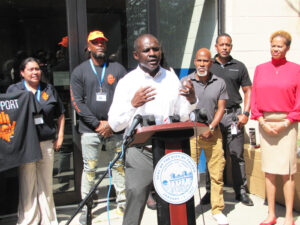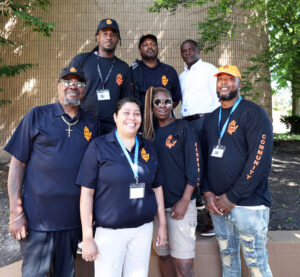
By Asia Nail
The Truth Reporter
Violence interruption is effective, but it takes intensive and sustained effort. David Bush is honored to lead the city’s interrupter program, a position that he has spearheaded since May.
“There is a story behind every fired bullet,” explains Commissioner Bush.
Bush, born and reared here in Toledo, knows all too well the personal stories of many of the city’s underserved. Bush has been serving as a passionate change agent for the City for the past 23 years. For decades he has worked with the Toledo Lucas County Public Library, engaging the community on the importance of lifelong learning and fostering inclusive environments where our city’s youth also have ‘a seat at the table.’ Bush is now the City of Toledo’s commissioner for Save Our Community, a violence deterrent initiative in the city.
Bush is also the founder and executive director of MADD Poets Society Inc., sharing “We teach poetry as a holistic means of healing trauma and the human condition.”
Last year Mayor Wade Kapszukiewicz announced plans to heal the city by reducing violence —saying, “There are a lot of steps involved in treating gun violence as a public health crisis, and we have sought to be aggressive and creative. We have seen gun violence spike across the country, and it is clearly a byproduct of the pandemic. As a part of our multi-component strategy, we have engaged with Cure Violence™️, a global organization dedicated to creating safer communities.”

The City of Toledo initiated its own adaptation of Cure Violence, starting in the Junction-Englewood neighborhood, to tackle the city’s rise in gun violence and to build connections to community resources for high-risk individuals. Toledo’s own, Save Our Community currently operates under the Mayor’s Initiative to Reduce Gun Violence.
“It was an honor to be chosen as the new commissioner of SOC,” says Bush.
Bush began his new position as commissioner at the end of May, and already he’s making headway into progressively canvassing the Lagrange Street corridor. “Residents dealing with violence call us from all around the city,” explains Bush. “Most are surprised when we explain Lagrange is only the second neighborhood to be recently added to the program.”
Still, Save Our Community is making a big impact and planning to expand to East Toledo soon.
“Our goal is to have a positive effect on any risky behaviors or events for those with a high chance of either being shot or being a shooter in the immediate future,” explains Commissioner Bush.
The Save Our Community program prevents violence through a three-pronged approach: detection and interruption; behavior change and changing community norms concerning violence acceptance.
Save Our Community’s program is a research-based community-centric approach to violence prevention. As an adaptation of the Cure Violence Model, the program maintains that violence is a learned behavior and that it can be prevented using disease control methods.
High risk individuals in Central Toledo are generally young offenders between the ages of 16 and 25, gang members, or youth with consistent exposure to violence.
“An important part of my job is to garner the support and participation of key stakeholders in the community including local politicians, community organizations and police,” explains Bush. “Once this takes place, the SOC Outreach Workers & Interrupters can help guide the community in understanding and implementing the program’s resources to services.”
The fact that so many violence interrupters are former criminals has drawn concern from local law enforcement officials in the past.
“Interrupters are greeted with hugs and handshakes in neighborhoods now instead of getting side-eyed,” explains Commissioner Bush. “The community knows we aren’t law enforcement and the cops know we aren’t against them either. Our job is to help those at highest risk before things ever escalate to the police.”
The core components of daily activities for the Save Our Community team consists of:
- Outreach workers who work directly with high-risk individuals, gang members and troubled youth to provide direct services and mediate disputes before they become violent events. They mentor and counsel youth, assess their needs, connect them with a broad range of services like educational development programs, anger-management counseling, and drug or alcohol treatment and help them find child-care or employment.
- Interrupters who mediate gang or neighborhood disputes. They work the streets at night, talk to gang leaders, distraught friends and relatives of recent shooting victims, and others who are in a position to initiate or continue cycles of violence, with the goal of establishing a rapport with the at-risk youth.
- Community mobilization efforts are promoted through community-level activism and public education. Activities include: media campaigns, rallies, protests, and town hall meetings. Local churches and community groups participate in marches, rallies, and prayer vigils focused on reinforcing the unacceptability of violence in the Toledo community. Educational materials designed to change normal behavior about violence and enhance knowledge of the risks of engaging in violence are also distributed throughout Central Toledo.
Save Our Community’s Junction-Englewood region is housed within the Frederick Douglass Center with Outreach Specialist Eduardo Adams supporting his area’s Interrupters: Ricky Gaines, Matthew Smith Jr. and Brandon Awls.
The program’s Lagrange St. Corridor region is housed within the Zablocki Center with Outreach Specialist Issac Miles supporting his area’s Interrupters: Christopher McIntyre, Elizabeth Matthews and Christopher Matthews.
Last year there were a total of 75 homicides in Toledo. “Last year was extreme. Homicides are down this year to 34 in the city and if Toledo continues on the same pace of projections, we hope to be under 45,” says Commissioner Bush. “East Toledo was our logical next choice which is the third big puzzle of the central city area.”
In response to residents’ pleas to expand Save Our Community, East Toledo is the next logical choice.
“We are planning on expanding to East Toledo in late September and are excited to welcome Diana Vasquez as East Toledo’s region Outreach Specialist,” shares Bush.
Historically, the program has had some interruptions. There’s been high turnover — the previous director, JoJuan Armour, resigned from his post in March.
“Former Commissioner JoJuan Armour did a great job during his time here. He was very effective,” shares Bush. “We are full force now with nine on the team and we are determined to break the cycles of violence and poverty in Toledo’s central city.”
The Violence Interrupters work Tuesday-Saturday along with the Outreach Specialists. Each area has a team of three Interrupters and one Outreach Specialist.
Interrupters canvas from 2 p.m. – 10 p.m. and Outreach Specialists work from 10 a.m. – 6 p.m. due to the front end of their job being reporting, logging paperwork, attending community events, and ensuring SOC participants receive resources. Each Interrupter can take up to five participants and enroll them into SOC’s programming.
High-risk participants can be involved as long as they have a need such as housing, food insecurity, clothing, mental health assistance, or even a simple employment resource.
“We are a part of bringing a village back to our Toledo community,” says Bush. “Folks want to know what’s in it for them? Generally, employment is one of the biggest positive gateways to instilling confidence in our participants. We want to interrupt their cycles of poverty, too.”
Any inner city that suffers from poverty, suffers from the ills of gun violence. Save Our Community is changing the norms of how people think about violence by providing regular training sessions for staff to enhance their knowledge of the program. This helps workers make appropriate decisions when they encounter situations with community members.
“Interrupters have their own triggers and trauma so it’s important that our programming provides training to not only participants but to our own staff,” says Bush. “Our team has received over 70 hours of training, including trauma and force training and stop the bleed training given by Toledo’s own nurses here at Mercy Medical that they can use when they are out canvassing.”
Program participants emphasize that Toledo’s Outreach Workers and Interrupters are doing a credible job, describing their work as a combination of trustworthiness and authenticity.
Save Our Community would like you to be part of a homegrown solution to our Glass City violence. Amid a historic surge in bloodshed during the pandemic, it has made a huge impact in its very concentrated canvased areas of Junction/Englewood and Lagrange Street.
Follow the work of Save Our Community on the City of Toledo’s social media pages and participating events to help them interrupt violence. You too, can be a very important part of Toledo’s growing village.

